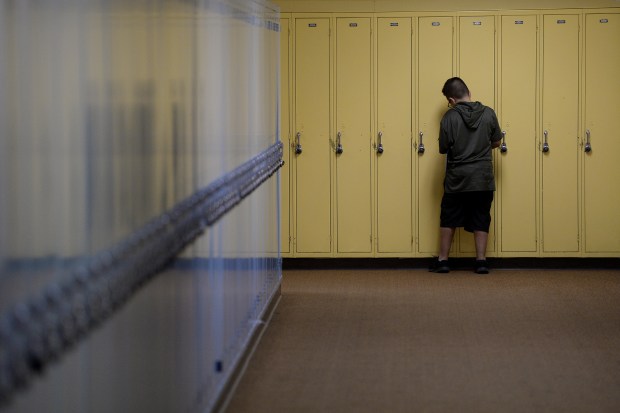As the coronavirus pandemic has upended classroom operations and district finances across Colorado, the four-day week may be poised to expand beyond the state’s rural school districts and into urban areas that have long resisted it.
Tracie Rainey, executive director of the Colorado School Finance Project, said the coronavirus could shake up the way districts approach the school calendar long after the pandemic subsides.
“I think you will see other districts start to talk about this within the community if the economic recovery is slow and school funding is going to be difficult for the legislature,” Rainey said, noting that many districts embrace four-day weeks as a cost-cutting move.
The last surge in four-day week adoptions in the state occurred following the Great Recession of 2008 and 2009, she pointed out. Now, more than 60% of school districts in Colorado — 113 of 178 — embrace the four-day model fully or in part. Yet it remains a largely rural phenomenon, with schools in Pueblo and Adams County the most notable exceptions.
With the economic collapse and social dislocation brought about by the pandemic, the table may be set for some of the state’s larger districts to adopt new ways of scheduling school, she said.
In fact, some metro Denver school districts have recently put four-day weeks on the table for discussion. Last fall, Littleton Public Schools considered it as a cost-saving measure to help plug an anticipated $4 million shortfall. And as the pandemic raged this past spring, the Douglas County School District contemplated whether to implement a curtailed week as a way of dealing with its coronavirus-battered budget.
Ultimately, neither district approved the shortened schedule, but the Douglas County school board indicated at an April meeting it may revisit the issue. Denver and Jefferson County school districts, the two largest in Colorado, told The Denver Post last week that they are not currently discussing four-day weeks.
But Paul Thompson, an associate professor of economics at Oregon State University and co-author of a recent paper on four-day weeks in K-12 schools, said that could easily change. With education leaders everywhere trying out myriad ways to deal with the pandemic — from remote learning to carefully controlled in-person instruction to a mix of the two — new approaches to scheduling school will likely emerge on the other side of the health crisis, he said.
Already, many districts in Colorado are holding aside one day a week as a planning, homework or online-only day, during which there is no live instruction.
“It’s essentially setting up a similar environment (to a four-day week),” Thompson said. “The conditions are there to have a similar spike in adoption that we saw 10 to 12 years ago.”
Seth McConnell, Denver Post file
A student opens his locker between classes at Overland Trail Middle School in Brighton on August 17, 2017. District 27J moved to a four-day school week the next year.
A largely rural choice
The first three school districts in the state signed up for a shortened week 40 years ago after the state legislature passed a law allowing school officials to try new approaches to scheduling. Districts must get approval from the Colorado Department of Education before offering a four-day week.
In the 2020-2021 academic year, Colorado has 113 districts that use a four-day week, making the state the nationwide leader in the number of school districts to do so. Still, less than 10% of the state’s students are under the shorter schedule because few large districts have adopted it.
East Grand School District in Granby was among the early adopters of the four-day week, making Fridays an off day starting in 1982. Superintendent Frank Reeves said it was partially born of a need for local kids to serve as lift operators for skiers getting a jump-start on the weekend at Winter Park Resort.
Students and staff in his district still get free ski tickets to use on Fridays, Reeves said.
“I don’t think there would be any desire by anyone to go back to five-day weeks up here,” he said with a chuckle.
But with only 1,300 students enrolled in East Grand across four buildings in Fraser and Granby, Reeves acknowledged the logistics of a shortened week are easier to execute in a small district like his than in a giant district like Denver, with close to 100,000 students. But COVID-19 may open doors that were once closed, he said.
Perhaps four-day weeks could be reserved for middle school and high school, where students are more independent and where less person-to-person interaction is needed as compared to elementary school-age students, Reeves said.
“It really is pretty exciting to think about what the future for our kids is and how creative we can be with our schedules,” he said. “I want to get rid of COVID, but I want to keep the whole creative mind-set.”
The crossover from small and rural to the urban Denver metro didn’t occur until 2018, when 27J Schools in Adams County adopted the four-day week. Superintendent Chris Fiedler said the district, with close to 20,000 students across Commerce City, Thornton and Brighton, made the move largely as a teacher recruitment and retention initiative.
With voters repeatedly rejecting school funding ballot measures, Fiedler said, 27J had to do something to keep its teacher corps from being lured to districts that can pay more. A three-day weekend became the pitch.
Resistance was stiff at first, especially from working parents who worried about how to obtain child care for their kids on the off day, Fiedler said, but the school board forged ahead. The district offers child care to several hundred families for $30 a day and partners with the Boys & Girls Club to provide programming for kids on Mondays.
It has been a success, he said. In a survey of parents, educators and students conducted earlier this year, 78% of respondents rated the change favorably.
“The biggest obstacle to the four-day week is politics,” Fiedler said. “Anytime you change anything with the school system, it’s going to be difficult.”

David Zalubowski, The Associated Press
Esperanza Raimirez works on a laptop in a classroom in Newlon Elementary School early Tuesday, Aug. 25, 2020. The school is one of 55 Discovery Link sites set up by Denver Public Schools where students are participating in remote learning.
Not for everyone
The four-day week may not, in fact, be right for every school district.
Thompson, the Oregon State professor who specializes in the topic, said the concept gained traction in rural areas because commute times to centrally located schools from faraway homes and farms can be lengthy. Also, the fifth day can be used to ferry students long distances to school-affiliated sporting events all over the state.
“That’s not an issue in urban and suburban areas,” Thompson said.
The research on four-day weeks, he said, reveals a mixed bag in terms of achievement and the social effects. One study showed positive effects on fourth- and fifth-grade math and reading proficiency rates in Colorado, but a study in Oregon concluded that the shorter week had negative effects on third- through eighth-grade math and reading achievement.
A third paper found negligible differences in district-level achievement between students on four-day and five-day week schedules in Oklahoma.
However, four-day school weeks led to an almost 20% increase in juvenile crime in Colorado because of increased “unsupervised time for children,” according to a 2018 study Thompson cited. Nationally, students on five-day-a-week schedules averaged 1,235 hours of instruction a year versus 1,150 a year for those going to school four days per week, he found.

Hyoung Chang, The Denver Post
Faculty members of Second Creek Elementary School check body temperatures of students near the entrance of the school in Commerce City on Thursday. Sept. 3, 2020.
As far as cost savings go, Thompson concluded that shortening the week reduced districts’ budgets less than 2% on average.
But an increasing number of school districts in Colorado have found that the four-day week works for them. And the pandemic is showing all districts that there are more ways than one to schedule school.
“I can’t think of another event in my life that has changed substantially how we deliver education than this event,” said Fiedler, the superintendent for 27J Schools. “We would be foolish not to be better on the other side of this (pandemic).”



















